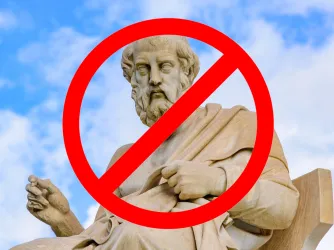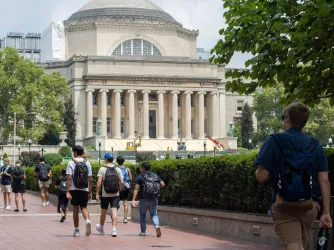Table of Contents
Unconstitutional ‘SAFER Act’ violates the First Amendment, undermines academic freedom, and seeks to upend decades of anti-discrimination law

Katherine Welles / Shutterstock.com
Earlier this month, Senators Bob Casey and Mazie Hirono and Representatives Jahana Hayes and Debbie Dingell introduced the “Students’ Access to Freedom and Educational Rights Act of 2022” (the “SAFER Act”; S. 5158/H.R. 9387) in their respective chambers of Congress.
If enacted, the SAFER Act would amend federal anti-discrimination laws in ways that would upend decades of legal precedent and threaten the civil liberties of students and faculty alike.
While there are numerous problems with the legislation, three of them stand out above the others.
Problem 1: The legislation would require schools to use an unconstitutional definition of sexual harassment.
The SAFER Act seeks to define sexual harassment in a way that would violate long-standing Supreme Court precedent and the First Amendment. The Supreme Court articulated a definition of discriminatory harassment in the educational context in a 1999 case, Davis v. Monroe County Board of Education. In an opinion authored by Justice Sandra Day O’Connor and joined by Justices Stevens, Souter, Ginsburg, and Breyer, the Court defined discriminatory harassment as conduct that is “so severe, pervasive, and objectively offensive, and that so undermines and detracts from the victims’ educational experience, that the victim-students are effectively denied equal access to an institution’s resources and opportunities.”
This speech-protective standard recognizes that federal anti-discrimination laws like Title IX must work in concert with the First Amendment. Courts have effectively used this standard to find in support of both students alleging that institutions failed to prevent prohibited harassment, and students alleging that their school violated the First Amendment by not adhering to this standard. Davis is still binding precedent, and it still protects students from both discriminatory harassment and censorship.
This provision will lead Title IX coordinators to attempt to control classroom content, and could lead to increased attempts by campus administrators to punish faculty speech protected by the First Amendment.
But the SAFER Act seeks to statutorily overrule Davis. Its definition of sexual harassment is a far cry from what Davis demands. Rather than “severe, pervasive, and objectively offensive,” the SAFER Act’s definition is “any unwelcome conduct of a sexual nature, regardless of whether it is direct or indirect, or verbal or nonverbal . . . .” If that sounds familiar, this unconstitutional definition is eerily similar to a 2013 settlement agreement between the U.S. Departments of Justice and Education with the University of Montana — often referred to as the “blueprint” definition — during the Obama administration. The SAFER Act’s definition is also reminiscent of another relic from that era. In a letter from the Department of Justice to the University of New Mexico, the DOJ declared that “[u]nwelcome conduct of a sexual nature” — including “verbal conduct” — is sexual harassment “regardless of whether it causes a hostile environment or is quid pro quo.” Under pressure from FIRE and other civil liberties advocates, the Department of Education eventually backed off the claim that all institutions must use the blueprint definition, telling FIRE in a November 2013 letter that “the agreement in the Montana case represents the resolution of that particular case and not OCR or DOJ policy.”
DAVIS v. MONROE COUNTY BOARD OF EDUCATION
The SAFER Act’s resurrection of the blueprint definition of harassment is deeply concerning. Most troublingly, the proposed definition fails to require, as Davis does, that the allegedly harassing conduct be “severe, pervasive, and objectively offensive.” Because the SAFER Act wouldn’t require an analysis of whether the conduct in question would be offensive to a reasonable person in the alleged victim’s position, the determination of whether expression has crossed into actionable misconduct would turn entirely on the alleged victim’s subjective sensibilities. It’s not difficult to imagine how the legislation would be devastating to campus expression if institutions could censor even the most innocuous speech due to it offending a single person. As a coalition letter that FIRE spearheaded in 2013 pointed out:
The threat to free expression and academic freedom is obvious; per the blueprint’s definition, a classroom discussion of Lolita, a campus reading of Allen Ginsberg’s “Howl,” a dorm-room viewing of a Sarah Silverman comedy routine, or a cafeteria debate about same-sex marriage will each constitute “sexual harassment” if a single student is made uncomfortable. This untenable result is plainly unconstitutional and sharply at odds with the United States Supreme Court’s famous conception of the American college campus as being “peculiarly the ‘marketplace of ideas.’” Healy v. James, 408 U.S. 169, 180 (1972) (internal citation omitted).
Not only are the “severe, pervasive, and objectively offensive” elements absent from the SAFER Act, but the proposed legislation is also missing Davis’s requirement that the conduct in question “effectively bars the victim’s access to an educational opportunity or benefit.” Effective denial may include instances in which a reasonable victim-student would stay away from class or student clubs, or choose to withdraw from a college or university. Instead, the SAFER Act relies on a much lesser standard, specifying that the conduct need only “unreasonably alter[] an individual’s terms, benefits, or privileges of an education program or activity, including by creating an intimidating, hostile, or offensive environment.” “Unreasonably alters” is an awfully vague standard. It will be difficult for speakers to ascertain what sex-related speech might “unreasonably alter” someone's experience on campus or subjectively create an “offensive environment.”
Problem 2: The SAFER Act undermines academic freedom by authorizing Title IX coordinators to regulate classroom content.
In addition to defending free speech and due process, FIRE vigorously defends the academic freedom of faculty at institutions of higher education. Unfortunately, Section 206 (b)(1)(B) of the SAFER Act puts academic freedom in the crosshairs by obligating Title IX coordinators to receive trainings on “evidence-based best practices for identifying and preventing implicit and explicit sex discrimination in all areas and at all levels of education, including . . . teaching practices, textbooks, and curricula.” (Emphasis added.)
This provision will lead Title IX coordinators to attempt to control classroom content, and could lead to increased attempts by campus administrators to punish faculty speech protected by the First Amendment and principles of academic freedom. Indeed, FIRE’s archives contain numerous examples where overzealous administrators sought to use Title IX to silence or punish faculty for academic expression. One clear example is that of Northwestern University Professor Laura Kipnis, whose writings questioning campus orthodoxies and Title IX policies spurred two Title IX investigations despite being squarely protected by academic freedom.
The SAFER Act should alarm all faculty because it would foster more of these illiberal investigations into professors. Academic freedom cannot withstand the SAFER Act’s intrusion into teaching practices, textbooks, and curricula.
Problem 3: The legislation would give schools 24/7 global control over student speech.
Institutions are morally and legally obligated to take meaningful steps to maintain educational environments that are free from discriminatory harassment. However, this crucial goal was never intended to justify a system in which campus bureaucrats have the authority to analyze and punish the speech of adult students or employees at all hours of the day and night no matter where they are. The SAFER Act would entrench such a system by subjecting institutions to liability for alleged harassment by students or faculty, “regardless of where the harassment occurs, if the [institution] receives notice of the harassment.”
Congress recognized the profound civil liberties implications that granting unfettered control over expression would pose when it crafted the federal anti-discrimination laws (title IX of the Educational Amendments of 1972 (Title IX), the Rehabilitation Act of 1973, title VI of the Civil Rights Act of 1964 (Title VI), and the Age Discrimination Act of 1975) that the SAFER Act seeks to amend. For example, the text of Title IX itself states:
No person in the United States shall, on the basis of sex, be excluded from participation in, be denied the benefits of, or be subjected to discrimination under any education program or activity receiving Federal financial assistance . . . (Emphasis added.)
In Davis, the Supreme Court discussed these jurisdictional limitations at length:
The language of Title IX itself particularly when viewed in conjunction with the requirement that the recipient have notice of Title IX's prohibitions to be liable for damages also cabins the range of misconduct that the statute proscribes. The statute's plain language confines the scope of prohibited conduct based on the recipient's degree of control over the harasser and the environment in which the harassment occurs. (Emphasis added.)
But the SAFER Act seeks to upset this longstanding balance by imposing liability on institutions for failing to address harassment, “regardless of where the harassment occurs, if the recipient receives notice of the harassment.”
Even putting aside the not-insignificant existing statutory limitations on schools’ control over students’ lives, the Supreme Court has acknowledged that while the government has custodial control over school children during school hours, it does not have the same authority to regulate the speech and conduct of adult college students. The Court in Davis explained that “the nature of [the State’s] power [over public school children] is custodial and tutelary, permitting a degree of supervision and control that could not be exercised over free adults.”
The SAFER Act does not live up to its name insofar as it places core civil liberties in jeopardy.
Even the government’s authority to regulate K-12 student speech is limited when the speech occurs outside of school grounds. In Mahanoy Area School District v. B.L., the Supreme Court rejected a school district’s assertion that it could police on- and off-campus speech even as to high schoolers, explaining:
[F]rom the student speaker’s perspective, regulations of off-campus speech, when coupled with regulations of on-campus speech, include all the speech a student utters during the full 24-hour day. That means courts must be more skeptical of a school’s efforts to regulate off-campus speech, for doing so may mean the student cannot engage in that kind of speech at all. When it comes to political or religious speech that occurs outside school or a school program or activity, the school will have a heavy burden to justify intervention.
If K-12 schools are limited in their ability to regulate off-campus speech of minors, it should go without saying that the government has an even higher burden to justify restrictions of off-campus speech of adult students, especially when the speech also falls outside contexts in which the institution has some control over the conduct.
Because the SAFER Act would grant institutions the authority — and indeed, the obligation — to police speech on sex-related topics regardless of where it occurs, the legislation also regulates the expression of faculty 24 hours a day from the moment they are hired, until they are no longer employed with the institution. This is true even when there is no connection at all between the extramural speech and the institution.
Conclusion
As clever as the acronym may be, the SAFER Act does not live up to its name insofar as it places core civil liberties in jeopardy. Our analysis here covers only a handful of the problems posed by the legislation. FIRE will have more to say on it in the weeks and months ahead.
Recent Articles
Get the latest free speech news and analysis from FIRE.

Can the Pentagon strip Mark Kelly’s rank over speech?

Texas A&M to philosophy professor: Nix Plato or be reassigned

Morgan State says cut the cameras, stop the presses



